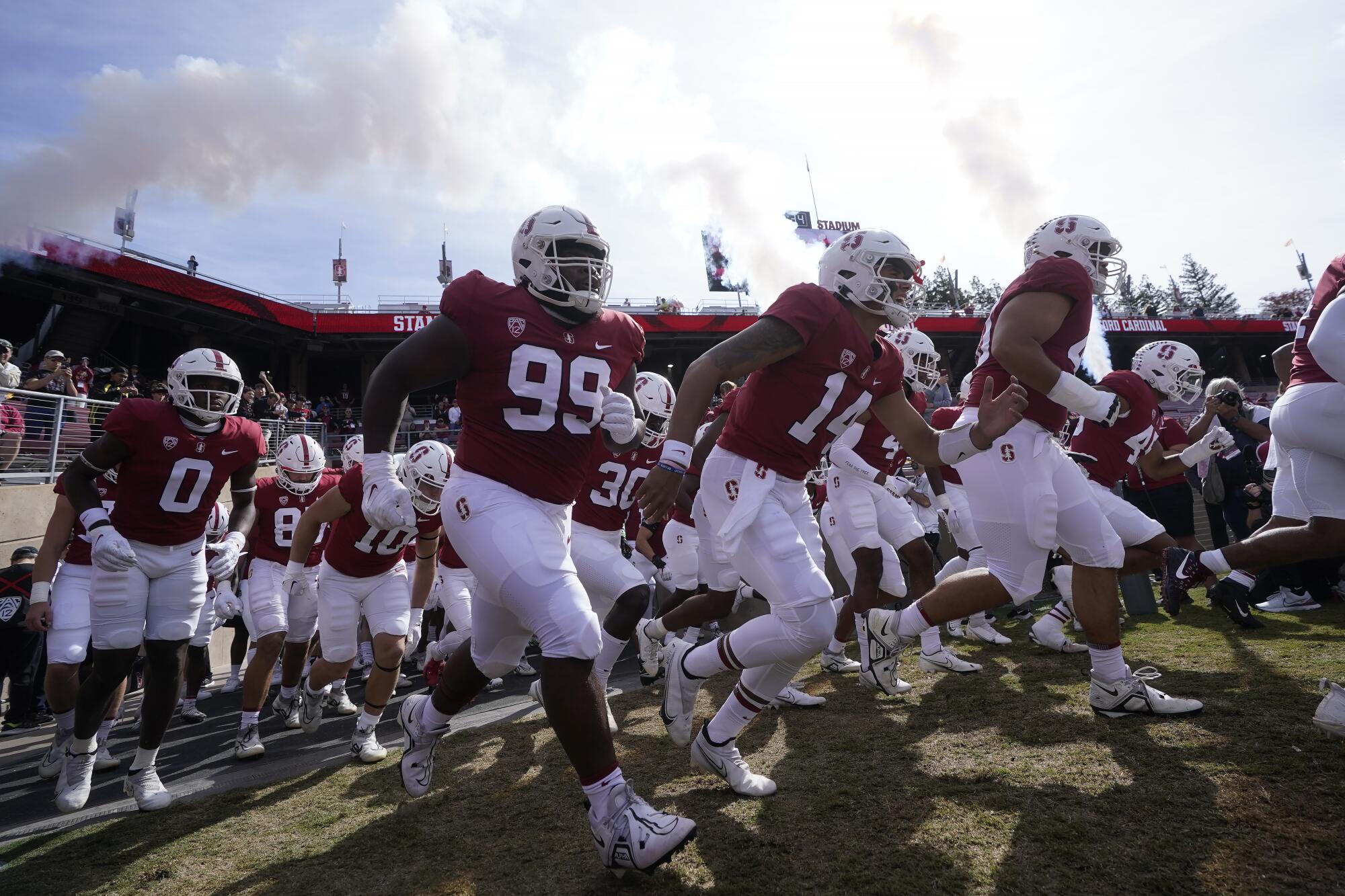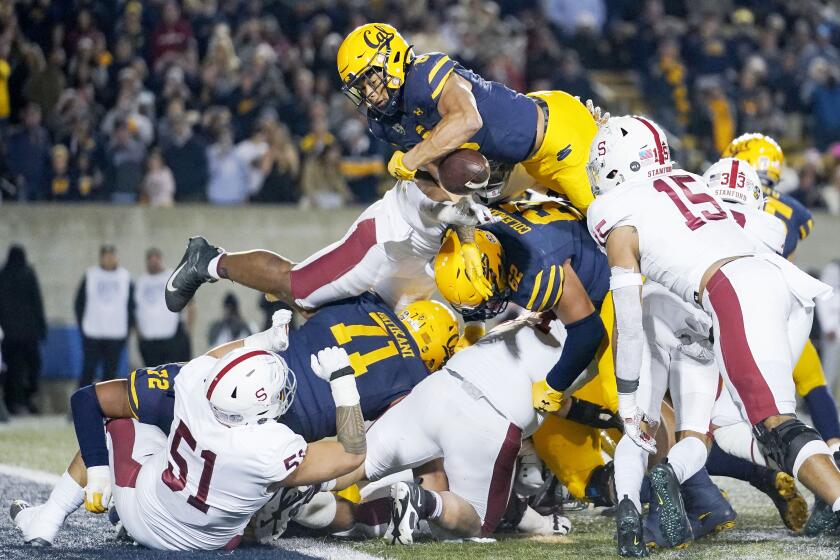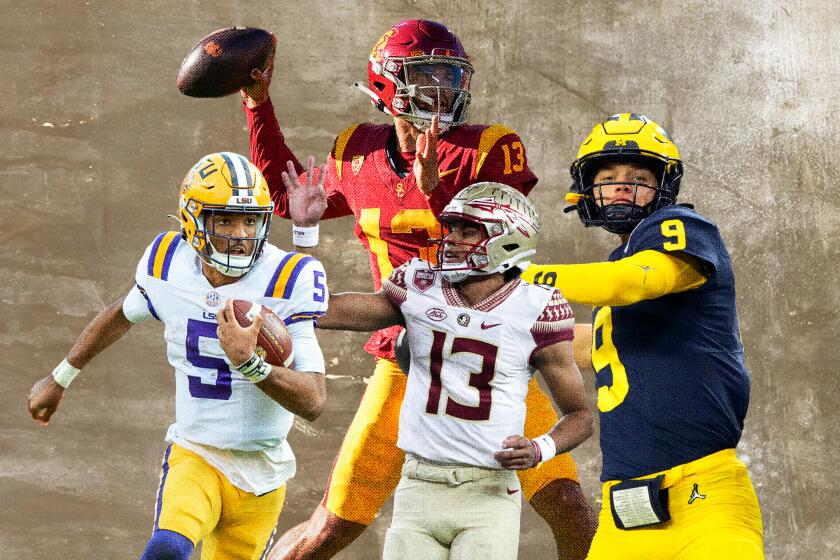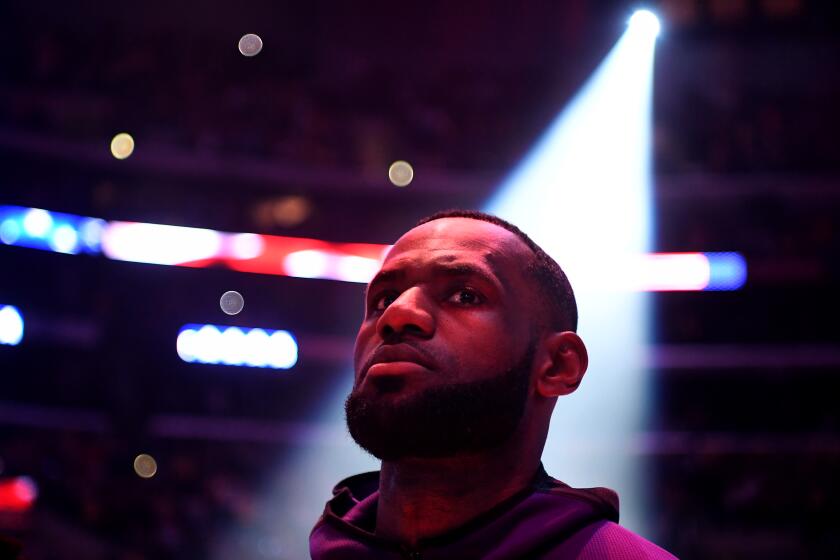
- Share via
It’s the fall of 2024. The Stanford and California men’s soccer teams need to play conference games to build their postseason resumes. They board flights — we won’t assume charter given the hurting athletic budgets of the schools — and land in the Dallas-Fort Worth Metroplex.
They hop on buses to take them into the open arms of Southern Methodist University, their well-heeled host and benefactor, and await the arrival of a cluster of East Coast teams from their new league, the Atlantic Coast Conference. Heck, maybe Notre Dame’s squad will show up too.
The teams will play a bunch of games against each other on some random pitch in sprawling North Texas to fill out the standings and be on their way.
Stanford and Cal have found new homes in the Atlantic Coast Conference, leaving just Washington State and Oregon State behind in the Pac-12.
Do the “student-athletes” play in front of any fans? Their friends? Their parents?
Do they get that extra jolt from representing their school on an opposing team’s campus, stealing a key road win?
This scenario is just one of the ridiculous ideas I’ve seen floated on how to make Stanford, Cal and SMU’s move to the ACC — made official Friday morning — work out for the hundreds of affected athletes who don’t play football or men’s basketball.
According to reports, the ACC schools finally found enough “yes” votes because of all the concessions the Bay Area Pac-12 leftovers and SMU in particular were willing to make.
The Mustangs, who never have recovered from receiving the NCAA death penalty in the late 1980s, were so desperate to return to a power conference that they promised not to take any media rights distributions for nine years. That means some of those same wealthy alums that put the football program down a path to ruin by paying players to attend SMU in its Southwest Conference heyday are going to be paying out about $300 million to get back that sweet taste of college football’s big-time.
Stanford and Cal will get only about a 30% share of the ACC’s distribution for seven years, likely in the range of $10 million to $12 million (and how much of that will go to travel?).
How did the Pac-12 die? These surprising decisions by USC, Oregon, Washington and others thwarted efforts to save the conference.
The leadership at those prestigious California institutions simply was unwilling to be paired up with Oregon State, Washington State and a collection of Mountain West schools — a situation that would be much better for the athletes’ quality of life — for the same reason they stuck up their noses at adding Big 12 schools to the Pac-12 two years ago:
They’ve convinced themselves that they’re better than you — unless you went to an Ivy League school, of course. They can continue to puff out their chests thanks to their inclusion in a conference with other schools that share an insufferable pride in their academics. They can say they found a new home with “like-minded” institutions, but let’s be clear: The only thing these schools share culturally is the blind devotion to riding the football gravy train.
The structure of college athletics is so broken it’s become redundant to say it. This is what happens when a system is failing the greater good but still is too profitable for the lucky few. University presidents just keep heaping bad, short-sighted decisions on top of one another because they know that when college sports truly crumble, they won’t be around to clean up the mess. It will be some other academic turned politician who is miscast making big decisions about sports.
Where do college football fans gather to watch games in Southern California? From Ohio State and Clemson to USC, use our guide to find your game-day spot.
When the top college football programs inevitably split off, Stanford and Cal won’t be on that ark. We can only hope they know that. All they did here was position themselves to be aligned with Duke, Virginia, Boston College, Wake Forest and others that won’t make that cut but have palatable reputations for future commingling.
The Pac-12 is officially dead. The Beavers and Cougars need a lifeline from the Big 12 or they’re bound for the Mountain West, it would seem. That’s actually really sad and immensely unfair, but it’s a feeling that is coming down the road for more current “power” schools, Stanford and Cal among them.
By expanding, the ACC did what it had to do to avoid the fate of the Pac-12, which chose not to expand and then paid dearly for it when USC and UCLA bolted for the Big Ten. The ACC has unhappy members like Florida State and Clemson that it will never make whole. Their exit eventually will happen, but now the ACC has strength in numbers (and coasts!) and will live on in some capacity as a second-level football league.

Give credit to ACC commissioner Jim Phillips for not following in the footsteps of George Kliavkoff. Phillips knew he was going to make a few schools mad, but he didn’t operate out of fear of losing them. He protected his league’s existence long-term — his No. 1 job.
Stanford and Cal will argue that they had no other choice, but I wouldn’t go that far. Stanford especially, as the emblem of what the “student-athlete” experience should be, could have stepped forward as a thought leader and said enough is enough. The Cardinal didn’t have to follow the crowd, and their students and alumni who are known for walking to their own drumbeat probably would have appreciated that.
Which teams will stand out during the 2023 college football season. J. Brady McCollough makes his picks and predictions for every Power 5 conference game.
But we shouldn’t be surprised at Stanford’s sheep mentality. The last few weeks, as the ACC debated expansion, I couldn’t help but think back to the pandemic, when Stanford tried to shutter 11 Olympic sports programs.
School leadership said then that it no longer had the budget. Because of a proposed lawsuit and immense public pushback, Stanford restored the sports, but the message remained. Every sport that didn’t make money was expendable at the mercy of football, even on “the Farm.”
It’s interesting. Stanford couldn’t subsidize men’s volleyball and sailing three years ago, but now it can stomach a drastic decrease in annual revenue and obscene travel costs?
Sure, it’s a long-term play. We can all see that. It was the easy call to make.
But for college sports to get the future right, at some point somebody in charge is going to have to start making some hard decisions.
That wasn’t going to be Stanford or the ACC in the midst of this wild, unhinged summer of 2023. So, on we go.
More to Read
Go beyond the scoreboard
Get the latest on L.A.'s teams in the daily Sports Report newsletter.
You may occasionally receive promotional content from the Los Angeles Times.















